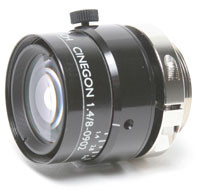IDS GigE UI-5240RE-M-GL R2 IP65 / IP67
Machine Vision Monochrome Camera
And
Ricoh FL-CC2514-2M
IP65 / IP67 cameras are hard to find,
especially at a good price. The latest version of this camera costs
over $1000. Just an IP65 / IP67 camera enclosure cost around $500.
This camera's body is a high quality IP65 / IP67 housing. The lens
cover is sealed and can fit a 2 inch or 50mm long c mount lens. It
has a clear glass Schneider Kreuznach 43 mm diameter filter at the
end of the cover. You can unscrew that filter and add your own as
needed.
This
is a 1280 x 1024 monochrome camera with very good dynamic range. The
imaging sensor is an EV76C560BB 1/2” CMOS chip with 5.3 x 5.3 um
pixels. The black level can be lowered in the camera to produce
excellent separation of the darkest shades of gray. This is somewhat
unique because black level is usually only additive, making most
cameras produce black with a brightness of around 30. I'm not sure
if the adjustment is happening at the 10 bit level or at the 8 bit
output, but the results speak for themselves. In the sample image
the 100% Black square at the top right is 0, the 90% Black is 24, the
White square is 248. This is the full dynamic range accurately
reproduced in 8 bits, coming from the camera, no post processing
required.
The
camera comes with a Ricoh FL-CC2514-2M 25mm, f/1.4, 2 megapixel
c-mount lens. It can accommodate up to a 2/3” chip (this camera
has a 1/2” chip). The lens is of solid quality glass and metal
construction. The Iris locking screw is bent, works fine, but that
indicates the lens hit something. I think the lens cover was
probably forced over the screw by an impatient installer with low
dexterity. Whatever bent the screw didn't effect the image quality
of the lens (see sample image for proof).
It's
a very good camera, and a great price... so is it too good to be
true?
No,
however it is an old camera. IDS is ending support for the camera
this year. The firmware doesn't support the new GEN<i>CAM GigE
vision standards. You have to use the IDS GigE driver Version 4.80.1
or earlier to set set up the camera's IP address.
Before
you buy this camera, download and install the IDS
Software Suite 4.80.1 WHQL
at
If
it runs on you PC your good to go.
You'll
need to get a power cable, the camera is not PoE. The power cable
needs a Binder Series 702 M9 7-pin or 8-pin female connector.
A 5 meter cable assembly Part # 79 1422 15 07
Pin
2 (BRN) is 12V – 24V DC, Pin 4 (YEL) is GND
 |
| Color code of the Binder cable id not the same as the IDS supplied cable. |
 |
| IDS camera connector pin out and IDS version of the Binder connector cable. The color code is different than the Binder cable above. |
 |
| Special version of the IO and power cable from IDS. |
You can use a
regular Ethernet cable, but to keep the IP65 / IP67 rating a Harting
RJ45 push/pull connector should be used. There are two parts, the
connector and the seal (Harting part numbers 09451451560
and 09455450033).
IDS
sells this as a kit
They are available separately from
Mouser by part number. www.mouser.com
Camera Specification
- Interface GigE - Requires IDS driver Version 4.80
- Lens Mount C-Mount
- Sensor Technology CMOS (e2v)
- Model Description (color) UI-5240RE-C
- Model Description (mono) UI-5240RE-M
- Resolution (h x v) 1280 x 1024
- Resolution Depth 10bit (10bit ADC)
- Resolution Category / Pixel Class 1.3 Megapixel
- Sensor Size 1/2"
- Shutter Global max. fps in Freerun Mode 50 fps
- Exposure Time in Freerun Mode 9µs - 2000ms
- Exposure Time in Trigger Mode 9µs - 2000ms
- AOI Modes horizontal + vertical
- Binning Modes horizontal + vertical
- Subsampling Modes ---
- I/O - Strobe 1 I/O - Trigger 1
- Sensor Model (monochrome) EV76C560BB
- Pixel pitch in µm 5.30
- Optical Size 6.784 x 5.427 mm
- Protection Classes IP65 / IP67
- Dimensions H/W/L 53.00 mm, 41.00 mm, 42.70 mm
- Mass 168.00 g
- Power Supply 12 - 24V
Lens specifications
- Manufacturer Ricoh (formerly known as Pentax brand)
- Model FL-CC2514-2M
- Format size 2/3, 1/1.8, 1/2, 1/3" format
- Focal length 25 mm
- Maximum aperture ratio 1:1.4
- Iris range 1.4~16
- Mount C
- Horizontal angle of view (degrees)
- 1/4" format 8.2
- 1/3" format 11.0
- 1/2" format 14.6
- 2/3" format 20.0
- Minimum object distance 0.25 m
- Back focal length 11.50 mm
- Filter size 27 P=0.5 mm
- Dimensions 29.5 mm diameter x 32 mm length
- Weight 55 g
- Remarks Focus & Iris lock screws
Thanks for viewing. Don't forget to
check my ebay items.
keywords
IDS Imaging Development Systems IP65 IP67 Monochrome Pentax Ricoh Schneider Kreuznach FL-CC2514-2M
f/1.4 c2514-m Binder series 702 712 7 pin 8 pin connector machine
vision computer vision camera Gigabit Ethernet GigE




























